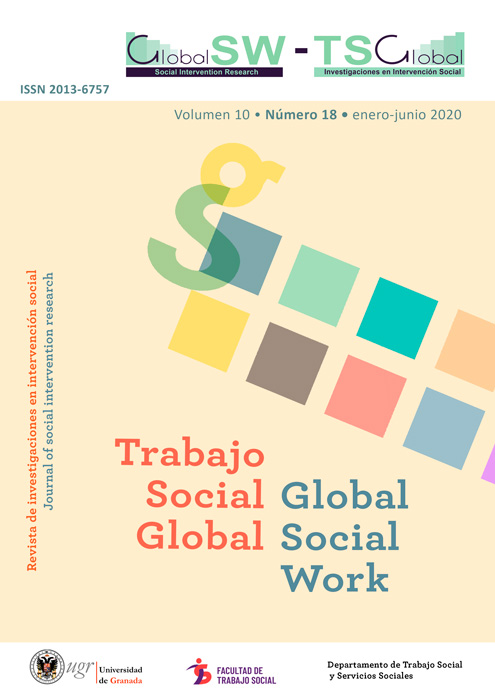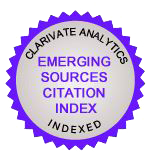Violencia en parejas de jóvenes chilenos: análisis y propuestas desde el Trabajo Social en el ámbito educativo
DOI:
https://doi.org/10.30827/tsg-gsw.v10i18.9345Palabras clave:
Jóvenes, Relaciones de pareja, Violencia, Trabajo social, Intervención socialResumen
El objetivo de este artículo es presentar un análisis de datos secundarios respecto de las diversas manifestaciones de violencia en las relaciones de parejas jóvenes chilenas y las percepciones de los jóvenes en torno a ellas. En Chile, estas relaciones se denominan “pololeo” y se caracterizan por la informalidad, la ausencia de vínculo legal, la desprotección jurídica y la provisoriedad. Se analizan datos secundarios de siete estudios realizados en Chile sobre la temática, entre 2012 y 2018, para luego presentar propuestas de intervención desde el Trabajo Social. Esta problemática influye directamente en la calidad de vida de los jóvenes y por tanto, desde el Trabajo Social se pueden proponer desde la intervención social algunas estrategias para su prevención desde el ámbito educativo.
Descargas
Citas
Bourdieu, P. (1999). La dominación masculina. Barcelona: Anagrama
Blandón-Hincapié, A. y López-Serna, L. (2016). Comprensiones sobre pareja en la actualidad: jóvenes en busca de estabilidad. Revista Latinoamericana de Ciencias Sociales, Niñez y Juventud, 14(1), 505-517. doi: http://dx.doi.org/10.11600/1692715x.14134271014
Bronfenbrenner, U. (1992). Ecological systems theory. En Ross Vasta (Ed.). Six theories of child development: revised formulations and current issues. (pp. 187-249). Bristol: Jessica Kingsley Publisher.
Castañeda P. y Urquieta, M. A. (2012). Estudio exploratorio sobre relaciones de pareja en adolescentes de establecimientos educacionales públicos y particular subvencionados de las comunas de Valparaíso y Viña del Mar y desde la perspectiva de violencia de género. Recuperado el 3 de mayo de 2019, de: https://es.scribd.com/document/432540784/Violencia-en-El-Pololeo
Dávila, O., Ghiardo, F. y Medrano, C. (2006). Los Desheredados. Trayectorias de vida y nuevas condiciones juveniles. Valparaíso: Ediciones CIDPA. Recuperado de: http://www.cidpa.cl/wp-content/uploads/2013/05/Desheredados.pdf
González, R. y Santana, J. D. (2001). Violencia en parejas jóvenes. Psicothema 13(1), 127-131. Recuperado de: http://www.psicothema.com/psicothema.asp?id=423
Instituto Nacional de la Juventud. (2015). Octava Encuesta Nacional de Juventud. Instituto Nacional de la Juventud. Ministerio de Desarrollo Social. Gobierno de Chile. URI: http://biblioteca.digital.gob.cl/handle/123456789/1388
_____ (2016). Sondeo N°4: Violencia en el pololeo. INJUV. Ministerio de Desarrollo Social. Gobierno de Chile. Recuperado de:
http://www.injuv.gob.cl/storage/docs/Sondeo_Violencia_en_el_pololeo.pdf
_____ (2018). Sondeo violencia en las relaciones de pareja: Visibilidad, denuncias y sanciones. INJUV. Ministerio de Desarrollo Social. Gobierno de Chile. Recuperado de: http://www.injuv.gob.cl/storage/docs/Revista_RT_INJUV_28_2018.pdf
Ley nº 20480, modifica el Código Penal y la Ley Nº 20.066 sobre Violencia Intrafamiliar, estableciendo el "Femicidio", aumentando las penas aplicables a este delito y reforma las normas sobre Parricidio. Diario Oficial de la República de Chile, Santiago, Chile, 18 de diciembre de 2010. Recuperado de:https://www.leychile.cl/Navegar?idNorma=1021343
Ley n° 20066, establece Ley de Violencia Intrafamiliar. Diario Oficial de la República de Chile, Santiago, Chile, 7 de octubre de 2005. Recuperado de: https://www.leychile.cl/Navegar?idNorma=242648
Ministerio de Salud. Gobierno de Chile. (2010). Encuesta Nacional de Salud Chile, 2009-2010. Tomo I, Resumen ejecutivo y equipo de trabajo. Santiago de Chile. Pontificia Universidad Católica de Chile y Universidad Alberto Hurtado. Recuperado de: https://www.minsal.cl/portal/url/item/bcb03d7bc28b64dfe040010165012d23.pdf
Ministerio de Salud. (2012). Programa Nacional de Salud Integral de Adolescentes y Jóvenes. Plan de Acción 2012-2020. Santiago de Chile: Editorial Valente. Recuperado de: https://www.minsal.cl/portal/url/item/d263acb5826c2826e04001016401271e.pdf
Navarrete, N. (2016). El papel del trabajo social en el ámbito educativo. Folios de Humanidades y Pedagogía, (6), 37-46. Recuperado de https://revistas.pedagogica.edu.co/index.php/FHP/article/view/6418/6049
Póo A. M. y Vizcarra, B. (2008). Violencia de Pareja en Jóvenes Universitarios. Terapia Psicológica, 26(1), 81-88. doi: http://dx.doi.org/10.4067/S0718-48082008000100007
Sanhueza, T. (2016). Violencia en las relaciones amorosas y violencia conyugal: Convergencias y divergencias. Reflexiones para un debate. Revista Última Década, 24(44), 133-167. doi: https://doi.org/10.4067/s0718-22362016000100006
Saldivia, C. y Vizcarra, B. (2012). Consumo de drogas y violencia en el noviazgo en estudiantes universitarios del Sur de Chile. Terapia Psicológica, 30(2), 43-49.doi: http://dx.doi.org/10.4067/S0718-48082012000200004
Servicio Nacional de la Mujer y Equidad de Género (s.f.). Femicidios. Recuperado el 3 de mayo de 2019 de: https://www.sernameg.gob.cl/?page_id=27084
Vivanco, R., Espinoza, S., Romo, C.; Véliz, A. y Vargas, A. (2015). Perpetración y victimización de la violencia en relaciones de parejas en jóvenes que cursan educación superior en la ciudad de Osorno, Chile. Polis (Santiago), 14(40), 489-508. doi: 10.4067/S0718-65682015000100023
Vizcarra, M., Póo, A. (2010). Violencia de pareja en estudiantes universitarios del sur de Chile. Universitas Psychologica, 10(1), 89-98. doi: https://doi.org/10.11144/Javeriana.upsy10-1.vpeu
Vizcarra, M., Póo, A. y Donoso, T. (2013). Programa educativo para la prevención de la violencia en el noviazgo. Revista de Psicología, 22(1), 48-61. doi: 10.5354/0719-0581.2014.29976
Wolfe, D., Wekerle, C., Scott, K., Straatman, A., Grasley, C. & Reitzel-Jaffe, D. (2003). Dating Violence Prevention with At-Risk Youth: A Controlled Outcome Evaluation. Journal of Consulting and Clinical Psychology 71(2), 279-291. doi: https://doi.org/10.1037/0022-006X.71.2.279
Descargas
Publicado
Cómo citar
Número
Sección
Licencia
Las personas autoras que publican en esta revista están de acuerdo con los siguientes términos:
- Las personas autoras conservan los derechos de autoría, garantizando a Trabajo Social Global-Global Social Work el derecho a la primera publicación del trabajo que remiten a la revista para que sea sometido al preceso editorial.
- Autores y autoras conocen que su obra se publica bajo una Licencia Creative Commons que permite a otros compartirla con un reconocimiento de la autoría del trabajo y de su publicación inicial en esta revista.
- Los/as autores/as ceden a Trabajo Social Global-Global Social Work los derechos de explotación de la obra que haya sido publicada en esta revista, autorizando a la Editorial de la misma para el ejercicio de una libre reproducción, distribución y comunicación pública. Autores y autoras conocen que su obra será almacenada en servidores y reproducida en soporte digital para su incorporación a repositorios institucionales y bases de datos que facilitarán el acceso libre y gratuito al texto completo de la obra.
- Los/as autores/as pueden distribuir la versión post-print de la obra publicada en TSG-GSW (por ejemplo, situarlo en un repositorio institucional o publicarlo en un libro), con un reconocimiento expreso de su publicación inicial en esta revista.
Los derechos de copyright sobre los textos publicados en Trabajo Social Global-Global Social Work, así como la política editorial de la misma respecto al auto-archivo o depósito en repositorios institucionales o temáticos, están identificados en la base de datos Dulcinea.






















